Compaq Presario 2800 Pentium 4-M 1.7GHz Notebook
by Matthew Witheiler on May 10, 2002 12:18 AM EST- Posted in
- Laptops
Construction - Under the Hood
The Compaq Presario 2800T packs quite a bit of punch in a relatively small space. The system we got a chance to evaluate came with a 1.7GHz Mobile Pentium 4-M processor, 256MB DDR memory, a 30GB hard drive, and an internal DVD/CD-RW drive.
The Presario 2800T that we received made use of the second fastest mobile Intel CPU out there, the Mobile Pentium 4-M clocked at 1.7GHz. Like we described in our WinBook N4 1.8GHz review, the Mobile Pentium 4-M provides quite a few advantages over other mobile Intel chips, including advanced SpeedStep technology which dynamically clocks the processor between 1.7GHz and 1.2GHz depending on need and increased L2 cache associated with the Northwood core that the CPU is based upon.
The CPU is hidden deep within the Presario 2800T and requires a bit of disassembly to get to. As with all laptops, cooling plays a major role in the Presario 2800T's design. The 1.7GHz Mobile Pentium 4-M chip is cooled by a fan that blows across two heatsinks above and to the right of the cooling far. Heat is transferred from the CPU to the heatsinks using two separate thermal pipes.
Like the other Mobile Pentium 4-M solutions we have seen, the chip sits inside a Molex style socket that allows for easy removal of the chip with a twist of a screw. Unlike the desktop Pentium 4 solutions, the Mobile Pentium 4-M chips do not include a heat spreader.
The system makes use of Intel's 845MP chipset to provide communication to and from the CPU. As described before, the chipset is very similar to the desktop 845 DDR motherboard, including features such as a 400MHz processor bus speed, up to a 266MHz DDR memory bus, and support for external AGP 4X graphics. Both the northbridge and the southbridge of the chipset are located on the top of the motherboard. The warm-running northbridge is cooled by a large metal plate that not only provides surface area for the chip's heat to escape to, it also provides structure to the notebook itself.
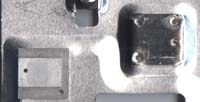
The graphics processor at the heart of the Presario 2800T is a Mobility Radeon 7500 with a 64MB 128-bit DDR video memory, a pairing the provided for one powerful mobile 3D system. The Mobility Radeon 7500 is very similar to it's desktop counterpart. In fact, the Mobility Radeon 7500 proves to be only slightly less powerful than the desktop part with the same model number, with the Mobility Radeon 7500 running at a 270MHz core clock and a 183MHz DDR memory clock and the desktop Radeon 7500 running at a 290MHz core clock and 230MHz DDR memory clock. Other than the core and memory clock speed differences, the Mobility Radeon 7500 is a desktop Radeon 7500 with a few extras important to notebooks.
On top of the Charisma engine, HyperZ technology, and Hydravision support that accompanies the desktop Radeon 7500, the Mobility Radeon 7500 includes quite a few notebook unique features. First off, the Mobility Radeon 7500 integrates as many video components on chip as possible. Two key components, the TV-out encoder and TMDS are integrated on the Mobility Radeon 7500 chip. Depending on the specific Mobility Radeon 7500, up to 32MB of memory can also be included on the chip. These integration methods save space as well as power. Our chip, the Mobility Radeon 7500 P, had no integrated memory but instead used an external 64MB 128-bit DDR video memory.
Perhaps the most impressive aspect of the Mobility Radeon 7500 is its power management technology. Coined Powerplay by ATI, the technology enables power saving techniques more advanced than previous mobile GPUs. First off, the Mobility Radeon 7500 has the ability to clock gate which allows the chip to essentially turn off parts, or blocks, of the GPU. For example, in a 2D environment where the only display used is the laptop's LCD panel, only the LVDS and the 2D engine on the chip are powered. The remainder of the chip is essentially shut down.
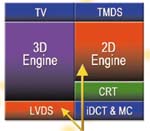
Since the chip has a high level of integration, this power saving technique has the potential to significantly decrease power consumption of the graphics processor.


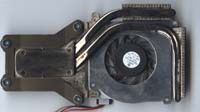
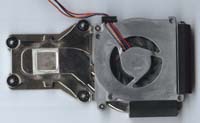
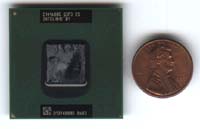









0 Comments
View All Comments